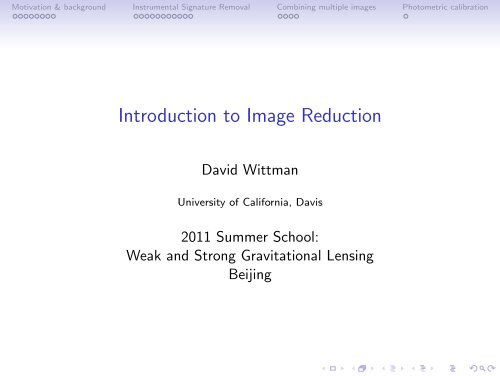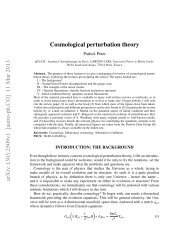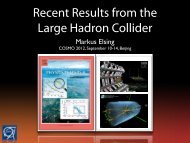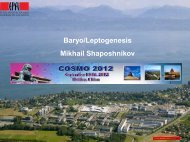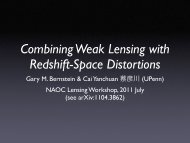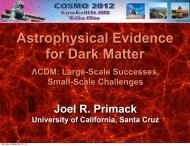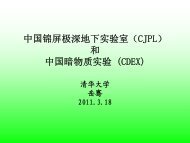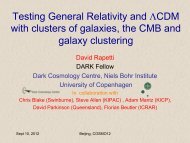Introduction to Image Reduction
Introduction to Image Reduction
Introduction to Image Reduction
Create successful ePaper yourself
Turn your PDF publications into a flip-book with our unique Google optimized e-Paper software.
Motivation & background Instrumental Signature Removal Combining multiple images Pho<strong>to</strong>metric calibration<br />
<strong>Introduction</strong> <strong>to</strong> <strong>Image</strong> <strong>Reduction</strong><br />
David Wittman<br />
University of California, Davis<br />
2011 Summer School:<br />
Weak and Strong Gravitational Lensing<br />
Beijing
Motivation & background Instrumental Signature Removal Combining multiple images Pho<strong>to</strong>metric calibration<br />
Goals<br />
Everyone believes an experiment except the experimenter; no one<br />
believes a theory except the theorist.<br />
So my goals are<br />
• <strong>to</strong> give theorists some appreciation of observational difficulties<br />
• <strong>to</strong> give potential observers a roadmap
Motivation & background Instrumental Signature Removal Combining multiple images Pho<strong>to</strong>metric calibration<br />
What do you see on a raw image?
Motivation & background Instrumental Signature Removal Combining multiple images Pho<strong>to</strong>metric calibration<br />
What do you see on a raw image?<br />
Some things can be removed (or at least masked) as part of instrumental<br />
signature removal:<br />
• response (“flatfield”)<br />
variations<br />
• saturation and bleeding<br />
• cosmic rays<br />
• bad columns or areas<br />
• different amplifier gains<br />
• fringing (if present)<br />
Instrumental signature removal “cleans” your images:<br />
→<br />
and allows you <strong>to</strong> do relative pho<strong>to</strong>metry (these are not the same thing!).
Motivation & background Instrumental Signature Removal Combining multiple images Pho<strong>to</strong>metric calibration<br />
Beyond ISR<br />
ISR is also necessary before you can combine multiple images:<br />
20x →<br />
Other effects will be treated later:<br />
• point-spread function (PSF): the response of the optical<br />
system <strong>to</strong> a point source is not a point<br />
• pho<strong>to</strong>metric calibration: comparing with standard stars <strong>to</strong><br />
calibrate sources in terms of Wm −2 s −1 (in the relevant<br />
bandpass)
Motivation & background Instrumental Signature Removal Combining multiple images Pho<strong>to</strong>metric calibration<br />
Important parameters:<br />
• quantum efficiency<br />
How a CCD works<br />
Amplifier<br />
• full well and saturation/bleeding<br />
• charge transfer inefficiency<br />
One pixel<br />
• pixel size and (mostly) other variations: flatfield response<br />
• readnoise and gain (next page)
Motivation & background Instrumental Signature Removal Combining multiple images Pho<strong>to</strong>metric calibration<br />
Noise and S/N<br />
If electrons accumulate at a rate r, after a time t a pixel will contain rt<br />
electrons and the Poisson noise will be √ rt. The readout electronics add<br />
a Gaussian noise σ so that the signal-<strong>to</strong>-noise ratio is:<br />
S<br />
N =<br />
rt<br />
√<br />
σ + rt<br />
For long (“sky noise limited”) exposures S<br />
N ∝ √ t so it’s hard <strong>to</strong> go deep!<br />
(Note tradeoff with area.) Be aware short exposures suffer a relatively<br />
large read noise penalty.<br />
The amplifier applies a “gain” fac<strong>to</strong>r G <strong>to</strong> obtain a digital number (DN)<br />
or analog <strong>to</strong> digital unit (ADU):<br />
where G is in e − /ADU.<br />
ADU = rt<br />
G
Motivation & background Instrumental Signature Removal Combining multiple images Pho<strong>to</strong>metric calibration<br />
Major types of CCDs<br />
• Front vs back illuminated: Back is best<br />
for quantum efficiency.<br />
• Thick (∼ 100µm vs thin ∼ 10µm: thick<br />
increases red sensitivity and decreases<br />
fringing<br />
• type of antireflective coating strongly<br />
influences red/blue sensitivity<br />
FRONT<br />
BACK<br />
CMOS and infrared sensors are not CCDs because they have an<br />
amplifier on each pixel and can read nondestructively.<br />
.
Motivation & background Instrumental Signature Removal Combining multiple images Pho<strong>to</strong>metric calibration<br />
Ground-based vs space-based<br />
Ground Space<br />
Background high ∗<br />
low<br />
CR rate low high<br />
Charge transfer efficiency good degrades with time †<br />
Pho<strong>to</strong>metric stability variable stable<br />
Angular resolution limited by atmospheric “seeing” can be very good ‡<br />
Wavelength limitations some none<br />
Cost low high<br />
Typical reduction mode do-it-yourself (software provided) more au<strong>to</strong>mated<br />
∗ most galaxies are much fainter than “blank” sky!<br />
† result: streaking as shown at right<br />
‡ depends greatly on observa<strong>to</strong>ry parameters
Motivation & background Instrumental Signature Removal Combining multiple images Pho<strong>to</strong>metric calibration<br />
Instrumental signature removal: overview<br />
• mask: identify bad pixels/areas <strong>to</strong> eliminate them from the<br />
following computations<br />
• overscan: correct for the bias of each row<br />
• crosstalk: correct for “signals” from nearby amplifiers<br />
• debias: correct for spatial variation of bias<br />
• defringe: subtract fringe pattern due <strong>to</strong> sky lines if present<br />
• flatfield: correct for nonuniform response
Motivation & background Instrumental Signature Removal Combining multiple images Pho<strong>to</strong>metric calibration<br />
Masking<br />
• identify<br />
pixels/areas<br />
which are always<br />
bad (eg dark<br />
column at left)<br />
• on each image,<br />
identify unique<br />
bad areas<br />
• always take<br />
multiple shifted<br />
exposures <strong>to</strong> fill<br />
in bad areas
Motivation & background Instrumental Signature Removal Combining multiple images Pho<strong>to</strong>metric calibration<br />
Overscan<br />
Determines ADU level corresponding <strong>to</strong> zero light, by reading out virtual<br />
pixels after the last real pixel in each row.<br />
Subtract the overscan level from each row.
Motivation & background Instrumental Signature Removal Combining multiple images Pho<strong>to</strong>metric calibration<br />
Bias and dark frames<br />
Bias (or zero) frames measure how the zero-light ADU level changes<br />
across each row. Always take multiple frames per night and average them<br />
for a robust measure.<br />
Dark frames measure how this level changes with time: usually negligible<br />
in modern cameras, but you should always check.<br />
Subtract the bias or dark frame from each data frame.
Motivation & background Instrumental Signature Removal Combining multiple images Pho<strong>to</strong>metric calibration<br />
Defringing<br />
Fringes have a stable spatial pattern, but amplitude varies in time.<br />
Make a fringe frame by median-combining your data and high-pass<br />
filtering the result:<br />
On each science frame, subtract the fringe frame times the best-fit<br />
amplitude.
Motivation & background Instrumental Signature Removal Combining multiple images Pho<strong>to</strong>metric calibration<br />
Flatfielding<br />
Basic idea: make a “uniformly illuminated” image (see below) and divide<br />
your data frames by it.<br />
This image shows dust (dark rings)<br />
and center-<strong>to</strong>-edge illumination<br />
gradient (vignetting) .<br />
Instead of uniformly illuminated, we really want an image illuminated just<br />
as the science objects are, e.g., vignetted in exactly the same way.
Motivation & background Instrumental Signature Removal Combining multiple images Pho<strong>to</strong>metric calibration<br />
Standard flatfielding options<br />
• dome flats: most telescopes have a (roughly) uniformly<br />
illuminated white screen inside the dome<br />
• twilight flats: the sky itself is roughly uniform (on camera<br />
scales) at twilight<br />
• dark-sky flats: median-combine the science frames<br />
None of these is perfect, for two reasons:<br />
• sky (and dome) pho<strong>to</strong>ns can travel through the optical system<br />
in different ways than object pho<strong>to</strong>ns!<br />
• response is a function of color
Motivation & background Instrumental Signature Removal Combining multiple images Pho<strong>to</strong>metric calibration<br />
Beyond Standard Flatfielding<br />
Ubercal (Padmanabhan et al 2008): use object pho<strong>to</strong>metry from multiple<br />
shifted expsures <strong>to</strong> solve for a model of required flatfield corrections.<br />
minstr = mtrue + kA + f (x, y)<br />
where A is the airmass of each exposure (assuming a pho<strong>to</strong>metric night!).<br />
Solve for k, f (x, y), and mtrue for each star (nuisance parameters). f (x, y)<br />
should be zero if standard flatfielding has worked.<br />
Results from Deep Lens Survey: ∼ 0.05 mag variations
Motivation & background Instrumental Signature Removal Combining multiple images Pho<strong>to</strong>metric calibration<br />
Beyond Standard Flatfielding II<br />
Stubbs et al: calibrate each pixel’s response at each wavelength<br />
with a tunable laser:<br />
Pan-STARRS at 901 nm.<br />
This way the colors of the sources can properly be taken in<strong>to</strong><br />
account.
Motivation & background Instrumental Signature Removal Combining multiple images Pho<strong>to</strong>metric calibration<br />
Caution for wide-field cameras<br />
The pixel size (as projected on the sky) changes from center <strong>to</strong><br />
edge in wide-field cameras, due <strong>to</strong> optical dis<strong>to</strong>rtion.<br />
Pixels at corners subtend less sky and appear fainter on sky flats,<br />
but do not collect fewer pho<strong>to</strong>ns from stars and galaxies!<br />
Model the optical dis<strong>to</strong>rtion <strong>to</strong> remove this effect.<br />
Also account for this effect when repixelizing on<strong>to</strong> a uniform grid!<br />
(See, eg, Mosaic data reduction manual for a more detailed<br />
explanation.)
Motivation & background Instrumental Signature Removal Combining multiple images Pho<strong>to</strong>metric calibration<br />
Why don’t we remove effect of PSF by deconvolving?<br />
from GREAT08, Bridle et al<br />
Deconvolution works well only in the high-S/N limit. (Same is true of<br />
many classical image-processing techniques.)<br />
Lensers extract lensing-specific corrections from the PSF, or<br />
forward-model the whole process.
Motivation & background Instrumental Signature Removal Combining multiple images Pho<strong>to</strong>metric calibration<br />
Combining multiple images: overview<br />
Conceptually, simply “coadd” multiple images of the same field <strong>to</strong> obtain<br />
a higher S/N “stacked image.”<br />
20x →<br />
This is a form of lossy data compression with (usually) high compression<br />
and low loss.<br />
There may be better ways <strong>to</strong> analyze your dataset (eg comeasurement,<br />
model fitting), but you usually want a stack at least for reference<br />
purposes.
Motivation & background Instrumental Signature Removal Combining multiple images Pho<strong>to</strong>metric calibration<br />
Cosmic ray rejection strategies<br />
• Start by building observa<strong>to</strong>ries/cameras with low-radioactivity materials!<br />
• If you have only one image, you can still identify most CR (at the catalog<br />
stage) as narrower than the PSF:<br />
• If you have two unshifted exposures, you can compare and mask.<br />
• Most often, you have multiple exposures and you can reject CR while<br />
stacking<br />
• CR are not the only things that change from image <strong>to</strong> image: also<br />
asteroids and satellite trails.
Motivation & background Instrumental Signature Removal Combining multiple images Pho<strong>to</strong>metric calibration<br />
Combining multiple images: prerequisites<br />
• coordinate transforms between stack and each exposure<br />
• relative pho<strong>to</strong>metric throughput of each exposure<br />
• relative S/N of each exposure (for weighting)<br />
• masks for each exposure<br />
• sky model for each exposure<br />
• other metadata for each exposure: eg saturation level<br />
• (ignoring PSF for now)
Motivation & background Instrumental Signature Removal Combining multiple images Pho<strong>to</strong>metric calibration<br />
Combining multiple images: subtleties<br />
• clipping biases the pho<strong>to</strong>metry (eg stars get much peakier in<br />
good seeing). Best <strong>to</strong> identify outliers before stacking (eg<br />
with psf-matched difference imaging)<br />
• for the same reason, a pixel saturated in any exposure should<br />
be considered always saturated<br />
• it’s not clear how <strong>to</strong> combine exposures with very different<br />
PSFs. May be best <strong>to</strong> forward-model everything.<br />
• track how many input pixels go in<strong>to</strong> each output pixel (and<br />
their variance)
Motivation & background Instrumental Signature Removal Combining multiple images Pho<strong>to</strong>metric calibration<br />
Pho<strong>to</strong>metric calibration<br />
• on “cloudless” (pho<strong>to</strong>metric) nights, image (and reduce, pho<strong>to</strong>meter)<br />
standard star fields several times, at a range of airmass<br />
• model the effect of airmass (usually linear in mag) and derive a<br />
pho<strong>to</strong>metric zeropoint m0 such that mtrue = minstr + m0 at zero airmass:
Motivation & background Instrumental Signature Removal Combining multiple images Pho<strong>to</strong>metric calibration<br />
Next lecture:<br />
Turning your image in<strong>to</strong> a catalog of stars and galaxies and<br />
their properties.


